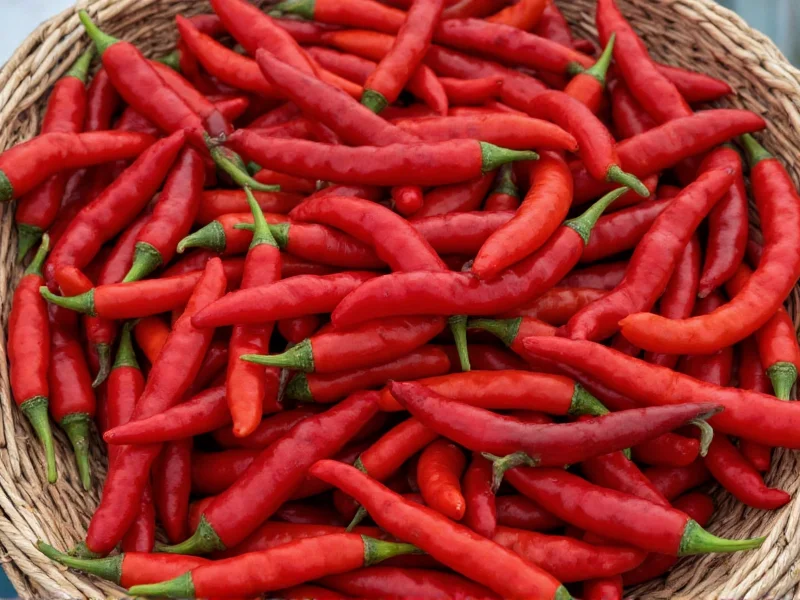When you're exploring Turkish cuisine or seeking unique spice alternatives, understanding what Urfa pepper is becomes essential for authentic flavor development. This specialty ingredient has gained international recognition among chefs and home cooks looking to elevate their dishes with nuanced heat and depth.
Origin and Traditional Production
Urfa pepper originates from the Şanlıurfa province in southeastern Turkey, where specific climate conditions contribute to its distinctive characteristics. Unlike standard chili flakes, authentic Urfa pepper undergoes a meticulous 10-15 day processing method:
- Peppers are harvested at peak ripeness
- Sun-dried during the day
- Covered and "sweated" overnight to develop deep color
- Tossed in/Dk oil (typically sunflower or sesame) after drying
- Hand-crushed to preserve texture and flavor compounds
This traditional technique creates the pepper's signature dark purple-to-black color and complex flavor profile that distinguishes it from other chili products. The overnight sweating process develops natural sugars while the oil coating preserves volatile compounds responsible for its unique aroma.
Flavor Profile and Heat Level
Understanding what Urfa pepper tastes like requires recognizing its multi-dimensional flavor:
| Characteristic | Description |
|---|---|
| Heat Level | Moderate (2,500-9,000 SHU) - milder than cayenne but with more complexity |
| Primary Flavors | Smoky, raisin-like, tobacco notes with subtle saltiness |
| Aroma | Earthy with hints of dried fruit and leather |
| Texture | Coarse flakes with visible salt crystals from processing |
Unlike many chili products that deliver straightforward heat, Urfa pepper offers what chefs call "flavor with fire" - the heat builds gradually after the initial flavor notes register on your palate. This delayed heat response makes it particularly valuable for creating layered flavor experiences in dishes.
Urfa Pepper vs Similar Chili Products
When exploring what Urfa pepper is in relation to other spices, several comparisons emerge:
- Urfa vs Aleppo pepper: Both Turkish chilies, but Urfa is darker, smokier, and slightly hotter than Aleppo's fruit-forward profile
- Urfa vs smoked paprika: Urfa offers more heat and complex fruit notes compared to paprika's one-dimensional smokiness
- Urfa vs standard chili flakes: Urfa's processing creates deeper flavor complexity versus the straightforward heat of generic chili flakes
Many home cooks searching for what Urfa pepper substitute works best find that a combination of smoked paprika and a touch of cumin comes closest to replicating its distinctive profile, though nothing perfectly matches authentic Urfa.
Culinary Applications
Professional chefs and home cooks use Urfa pepper in various applications where what Urfa pepper is known for—its complex flavor—can shine:
- Meat rubs: Particularly effective on lamb and beef where its smokiness complements rich flavors
- Dips and spreads: Mixed into hummus, labneh, or eggplant dips for depth
- Roasted vegetables: Sprinkled over finished dishes for flavor enhancement
- Breakfast dishes: Adds complexity to eggs and avocado toast
- Chocolate pairings: Surprisingly effective in dark chocolate desserts for sophisticated flavor contrast
When considering what Urfa pepper is used for in traditional Turkish cuisine, it frequently appears in breakfast dishes, kebabs, and as a finishing spice rather than cooked extensively, which preserves its delicate flavor compounds.
Storage and Shelf Life
To maintain Urfa pepper's distinctive characteristics, proper storage is essential. Unlike generic chili flakes, Urfa contains natural oils from its traditional processing that can degrade when exposed to elements. Store in an airtight container away from light and heat. Properly stored, it maintains peak flavor for 6-8 months, though it remains safe to consume beyond this period with gradually diminishing flavor intensity.
Identifying Authentic Urfa Pepper
With growing popularity, understanding what Urfa pepper should look like helps avoid imitations:
- True Urfa pepper appears dark burgundy to nearly black, not bright red
- It contains visible salt crystals from the traditional processing
- Authentic product lists "Isot" or "Urfa Isot" on packaging
- It has a distinctive aroma reminiscent of raisins and tobacco
Products labeled simply as "Urfa-style" or "Urfa blend" often lack the traditional processing methods that create the authentic flavor profile. When seeking what Urfa pepper is supposed to taste like, look for products specifying Şanlıurfa origin.
Frequently Asked Questions
Is Urfa pepper the same as Aleppo pepper?
No, while both are Turkish chili flakes, Urfa pepper is darker, smokier, and slightly hotter than Aleppo pepper. Urfa undergoes a unique sun-drying and oiling process that creates its distinctive raisin-like flavor, whereas Aleppo has a more fruit-forward profile with citrus notes and less smokiness.
How spicy is Urfa pepper compared to other common chilies?
Urfa pepper registers between 2,500-9,000 SHU on the Scoville scale, making it milder than cayenne (30,000-50,000 SHU) but hotter than standard paprika (500-1,000 SHU). Its heat builds gradually after the initial flavor notes, creating a complex experience rather than immediate burn.
What dishes work best with Urfa pepper?
Urfa pepper excels in meat rubs (particularly lamb), as a finishing spice for roasted vegetables, mixed into dips like hummus or labneh, and even in unexpected applications like chocolate desserts. Its complex flavor shines when used as a finishing spice rather than cooked for extended periods, which preserves its delicate aroma compounds.
Can I substitute regular chili flakes for Urfa pepper?
While possible in a pinch, standard chili flakes lack Urfa's distinctive smoky, raisin-like complexity. For closest approximation, combine 1 part smoked paprika with ½ part sweet paprika and a pinch of cumin. However, this substitute won't replicate the unique flavor development of authentic Urfa pepper's traditional processing method.
Why does authentic Urfa pepper contain salt?
The salt crystals in authentic Urfa pepper result from its traditional processing method. After sun-drying, the peppers are tossed in/Dk oil (typically sunflower or sesame) and then hand-crushed, which releases natural salts from the pepper itself. This process creates the distinctive saltiness that's characteristic of genuine Urfa pepper, not added table salt.











 浙公网安备
33010002000092号
浙公网安备
33010002000092号 浙B2-20120091-4
浙B2-20120091-4